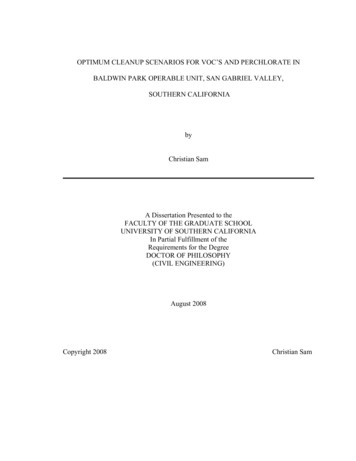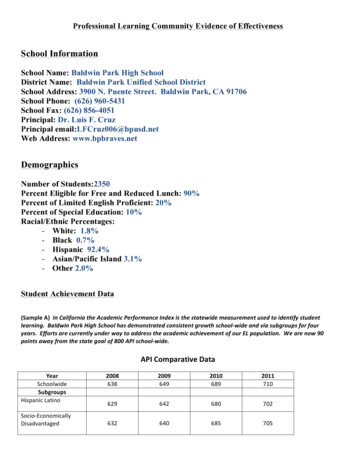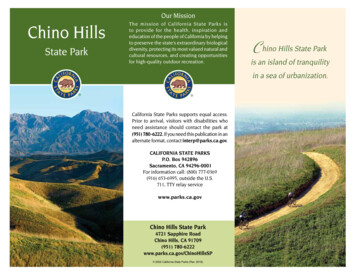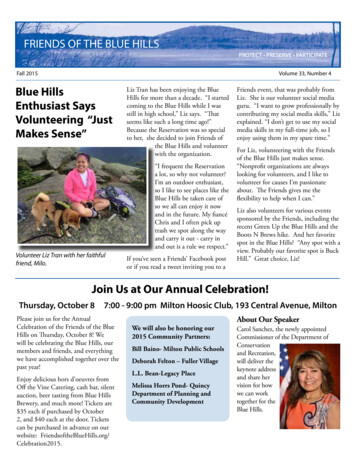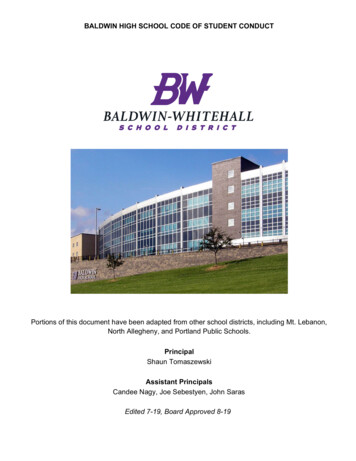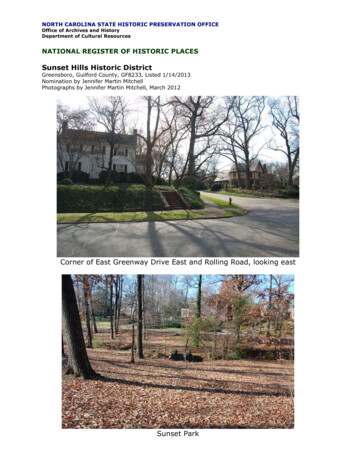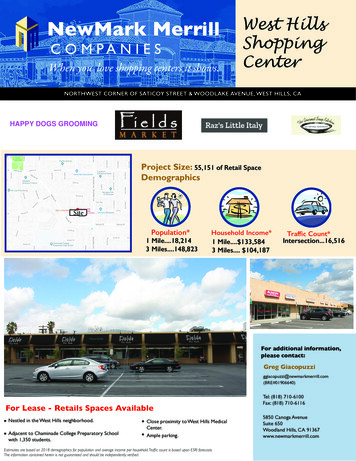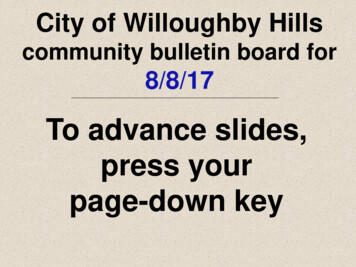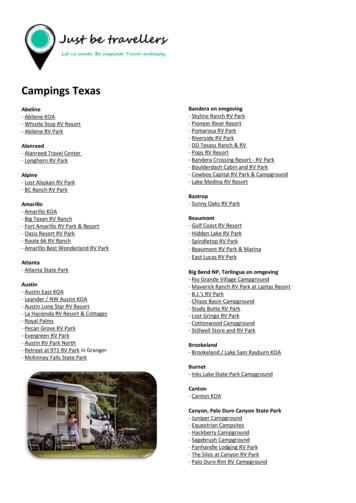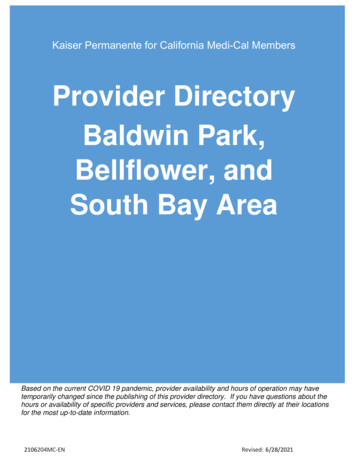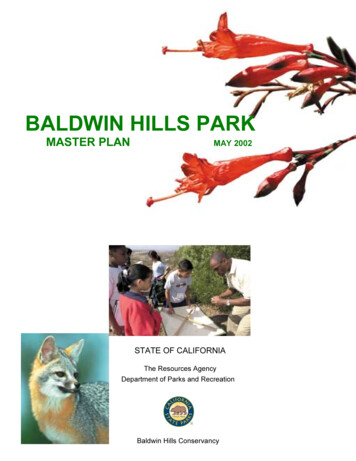
Transcription
BALDWIN HILLS PARKMASTER PLANMAY 2002STATE OF CALIFORNIAThe Resources AgencyDepartment of Parks and RecreationBaldwin Hills Conservancy
BALDWIN HILLS PARKMaster PlanMay 2 0 0 2Prepared byCommunity Conservancy InternationalForCalifornia Department of Parks and RecreationRUTH COLEMANActing DirectorandBaldwin Hills ConservancyDAVID McNEILLDirectorGRAY DAVISMARY D NICHOLSGovernorSecretary for ResourcesLandscape Architecture byMia Lehrer Associates and Hood Designii
TABLE OF CONTENTSLIST OF FIGURES, MAPS AND GRAPHICS .VILIST OF APPENDICES . VIIDEFINITIONS OF KEY TERMS.VIIIINTRODUCTION TO THE BALDWIN HILLS . 1INTRODUCTION TO THE BALDWIN HILLS . 2EXECUTIVE SUMMARY . 2Purpose of the Baldwin Hills Park Master Plan . 2Location. 3Community and the Planning Process . 4Partnerships . 5Sense of Place. 5History of the Baldwin Hills Park Master Plan . 8BALDWIN HILLS PARK SITE SUMMARY . 11Existing Land Uses. 11Passive Recreation.11Active Recreation .11Adjacent Land Uses.12Significant Resource Values. 12Physical Resources .13Topography .13Meteorology .13Hydrology .13Geology.14Oil and Gas .14Seismicity.15Erosion and Soils .15Natural Resources.15Overview.15Need for Connecting Habitat Areas .21Vegetation Types .21Coastal Scrub .21Grasslands.22Riparian Woodlands .22Sensitive and Special Interest Plant Populations.22Exotic Flora and Potential for Restoration of Native Species .22Animal Life .25Arthropods of the Baldwin Hills.25Exotic Species .25Reptiles and Amphibians of the Baldwin Hills .26Species of Concern .26Exotic Species and Potential for Restoration of Native Species .26Bird Species of the Baldwin Hills.26Species of Special Interest .27Exotic Species and Potential for Restoration of Native Species .27Mammal Species of the Baldwin Hills.27Species of Concern .28Exotic Species and Potential for Restoration of Native Species .28Restoring Natural Habitat and Establishing Habitat Corridors (see figure 10) .28Paleontology .29Cultural Resources and History (see Appendix E) .29EXISTING COMMUNITY INFRASTRUCTURE . 32iii
OPEN SPACE DEFICIT AND EXISTING PARK AND RECREATION RESOURCES . 32Open Space Deficit. 32Kenneth Hahn State Recreation Area . 33Ballona Creek Trail & Bikeway . 34AESTHETIC VALUES OF THE BALDWIN HILLS PLANNING AREA . 34Viewsheds . 34Natural Habitat . 37Human Development. 37Communication and Utility Towers . 37Noise 38PLANNING INFLUENCES . 38Community Planning Process. 38Recreation Patterns. 40Kenneth Hahn State Recreation Area Usage . 40Public Concerns. 41ISSUES AND ANALYSIS . 41Site Constraints and Limitations ( Figure 14). 41Topography .41Adjacent Neighborhoods .42Natural Habitat .42Roads and Traffic .42Adjacent Uses Requiring Masking .43Site Opportunities and Potential (see Figure 16) . 43Ridgelines and Views .43Connecting East and West Ridgelines .43Natural Habitat .43Greenway Connections.46Pedestrian Access and Trail Connections.46DECLARATION OF PURPOSE . 49DECLARATION OF PURPOSE . 50BALDWIN HILLS PARK DESIGN . 50Goals 50Park Concept Description: One Big Park . 50Landscape Character .51Land Bridge.52Natural Lands and Open Space .53Natural Lands and Open Space .54Park Activities & Facilities .54Playing Fields.54Multi-Use Fields/Festival Spaces.56Tennis Center .56Recreation Center.56Skate Parks.56Par Course and Climbing Wall.56Golf Course, Club House and Banquet Facility .56Cultural, Educational and Interpretive Facilities .57(See Figure 20).57Botanical Garden .57Sculpture Gardens.57Visitor, Interpretive and Education Centers .57Community, Art and Senior Center .57Oil History Site .58Amphitheater .58Public Safety, First Aid and Park Administration and Maintenance Facilities.58Public Safety and Law Enforcement.58Park Administration and Maintenance.58Restrooms .58Entrances, Parking, Park Shuttle System, Roads, Greenways and Street Trees .60Entrances .60Parking.61iv
Park Shuttle System .61Roads and Circulation.61Entrance Roads .62Internal Park Shuttle Roads.62Greenways and Street Trees.62Footpaths and Bicycle Trails.62Neighborhood Buffer Areas .63STATEMENT OF OVERALL MANAGEMENT INTENT . 67SPECIFIC MANAGEMENT GOALS . 671) Sustainability. 672) Protection of Natural Lands . 683) Provision of Active Recreation . 684) Golf Course . 685) Buildings and Visitor-Serving Uses . 686) Open Space Areas . 687) Public Access . 688) Access for the Disabled. 699) Circulation, Parking and Park Shuttle . 6910) Public Safety . 6911) State-Local/Public-Private Partnerships. 6912) Revenue-Generating Uses . 6913) Art and Aesthetics . 6914) Signage and Park Information. 70SPECIFIC MANAGEMENT AREAS . 70La Cienega Boulevard Park Entrance, Visitor/Education Center, North Central Valley Management Area . 70Vista Pacifica Scenic Site, Visitor Center . 70and Ballona Creek Trail Connection Management Area. 70Culver City Park Entrance and Ballona Creek Trail Connection Management Area . 71Culver City Park Active Recreation Management Area. 71West Los Angeles College Entrance and Trailhead Parking . 71Sculpture Garden Management Area. 71Amphitheater and Multi-Use Festival Management Area . 72Golf Course, Clubhouse, Banquet Facility Management Area. 72Ball Fields, Tennis & Recreation Center, Community & Senior Center . 72and Active Recreational Management Area . 72Five Points Park Entrance and Trails Connection Management Area. 72Stocker Street Trail and La Brea Greenway and Trail Management Area . 73Western Natural Preserve, Western Scenic Ridgeline, Wilderness Group Camping, and. 73Picnic Sites Management Area. 73Oil History Site Management Area . 74Eastern Natural Preserve, Eastern Scenic Ridgeline and Picnic Sites Management Area. 74North Central Valley Management Area. 74GENERAL MANAGEMENT GOALS . 74Economic Opportunities . 74Active Recreation . 75Restoration and Natural Habitat . 75Education & Interpretation . 76Art & Aesthetics . 76Park Maintenance . 77Public Transportation . 77Public Safety. 77INTERPRETATION AND EDUCATION . 77APPENDICIES . 81v
LIST OF FIGURES, MAPS AND GRAPHICSFigure 1:Location MapFigure 2:Neighborhoods of the Baldwin HillsFigure 3:Aerial ImageFigure 4:Shaded Relief MapFigure 5:Watershed Map of Los Angeles CountyFigure 6:Baldwin Hills Fault MapFigure 7:Oil Drilling Facilities MapFigure 8:Ecological Areas of Los Angeles CountyFigure 9:Detailed Vegetation Types MapFigure 10:Habitat Restoration Priorities MapFigure 11:Open Space Deficit in the Baldwin HillsFigure 12:Ballona Creek Trail & Bikeway ConnectionsFigure 13:Panoramic ViewsFigure 14:Site Limitations DiagramFigure 15:Slope Analysis MapFigure 16:Site Potentials DiagramFigure 17:IllustrationsFigure 18:Preliminary Kenneth Hahn State Recreation Area General Plan:One Big Park ConceptFigure 19:Park Element: Natural Lands & Open SpaceFigure 20:Park Element: Park Activities & FacilitiesFigure 21:Park Element: Entrances, Roads, Parking, Greenways & Street TreesFigure 22:Park Element: Footpaths & Bicycle Trailsvi
LIST OF APPENDICESAppendix A:Major Ethnic Groups & Latino Population Demographics MapAppendix B:Median Income & Households with Children Demographics MapAppendix C:Baldwin Hills Park Advisory CommitteeAppendix D:Land Use Designations MapAppendix E:Baldwin Hills History TimelineAppendix F:List of public workshopsWorkshop I ResultsWorkshop II ResultsAppendix G:Planning Area with City and County BoundariesAppendix H:Community Conservancy InternationalAppendix I:Mia Lehrer AssociatesAppendix J:Hood DesignAppendix K:GreenInfo Networkvii
DEFINITIONS OF KEY TERMSCommunity:Groups of species (plants, animals, people) that interact closely with oneanother.Exotic Species:Plant or animal species that does not naturally occur in an area, butwhose presence there is due to human activities.Habitat:A place or environment in which an animal or plant lives.Native:Those that have been in a particular place (in this case, in the BaldwinHills) since before European settlement.Natural:Untouched by the influences of civilization and human society.Population:A group of individuals of a species living in a particular area.Species:An organism, or groups of genetically-related individuals which shareimportant characteristics and which generally do not interbreed with othersuch groups.viii
Introduction to the Baldwin HillsExecutive SummaryThe Baldwin Hills are the last, large undeveloped area of open space in urban Los AngelesCounty, covering over two square miles of dramatic ridgelines and steep canyons. Close toboth downtown Los Angeles and the Pacific Ocean, the Baldwin Hills are easily accessible tomillions of residents, and provide unparalleled opportunities for outdoor recreation in a naturalsetting. Home to hundreds of species of native plants and animals, the Baldwin Hills provideimportant natural habitats, an example of the vast system of swamps, grasslands and riparianareas that once made up this area. Part of the Ballona Creek Watershed, drains into adjacentBallona and Centinela creeks which join the Pacific Ocean four miles downstream.The Baldwin Hills encompass 450 acres of protected parkland, including the Kenneth HahnState Recreation Area, the Ladera Ball Fields, the Vista Pacifica Scenic Site, Culver City Parkand Norman O. Houston Park. The Baldwin Hills have been used for oil and gas developmentsince the early 1900s, and numerous roads, oil wells, processing units and other oil and gasinfrastructure cover the remaining 950 acres. While these operations will remain as long as oilproduction is economically feasible, it is anticipated that the land in the Baldwin Hills willbecome available for park acquisition and development over time. The Baldwin HillsParkMaster Plan sets forth a comprehensive vision for improvement and restoration of theselands, so that over time a balance between active recreation, natural habitat and communityfacilities can be achieved.There is a compelling need for a comprehensive vision to unify the many pieces that make upthe Baldwin Hills – a plan that can be implemented over time so that 100 years from now thearea is a vibrant, living plac
vi LIST OF FIGURES, MAPS AND GRAPHICS Figure 1: Location Map Figure 2: Neighborhoods of the Baldwin Hills Figure 3: Aerial Image Figure 4: Shaded Relief Map
